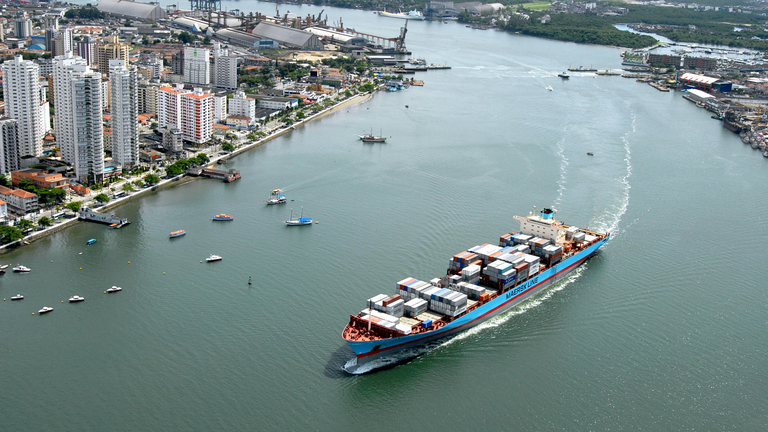Growth of 6.9% is driven by the transportation of solid vegetable bulk, iron ore, crude oil and others
In 2023, the Port of Santos (image) recorded a 7.7% increase in cargo handling, reaching 135.9 million tons
Brasília 07/02/2024 – Between January and December 2023, the Brazilian waterway sector handled 1.303 billion tons. The data is from the National Waterway Transportation Agency’s (ANTAQ) Waterway Performance 2023, released today by the agency. This is the highest volume handled in the historical series and represents growth of 6.9% compared to 2022.
Among the types of shipping, inland navigation stood out for its significant growth of 10.5%, followed by long-haul shipping, with an increase of +8.3% and, finally, cabotage, which grew by 1.6%.
Cargo profiles maintained the trend shown throughout 2023. The main goods handled by the waterway sector were soybeans (+29%), corn (+18%), crude oil (+9.4%) and iron ore (+7.6%). Another positive highlight was fertilizers (+6.9%).
In turn, containerized cargo fell by -0.5% and general cargo by -2.9%, according to the survey.
The best-performing public ports were Santos, Paranaguá and Itaguaí, which grew by 7.7%, 12.1% and 10.2% respectively, representing growth of 9.7 million, 6.3 million and 5.2 million tons compared to 2022, in that order.
The most notable Private Use Terminals in the year were the Tpet/Toil Oil Terminal – Açu RJ, which grew by 32.9%, the Porto Sudeste do Brasil S/A Terminal – RJ, which grew by 47.9%, and the Tubarão Terminal – ES, which grew by 11.8%. In tons, the increases compared to the previous year were 14.3 million, 8.9 million and 8.0 million, respectively.
Arco Norte movement outstrips the rest of Brazil
The waterway movement of soybeans and corn in the country’s Northern Arc surpassed that of the rest of the country. According to data from ANTAQ’s Waterway Statistics, ports and terminals in the Northern Arc handled 100.8 million tons in 2023, compared to 88.5 million tons the previous year. Handling in the rest of Brazil, below the 16°S parallel, reached 100.2 million tons, compared to 73.4 million in 2022.
The Arco Norte has become a fundamental alternative for transporting the country’s soybean and corn production, two commodities that have seen their exports triple and quintuple in the last 13 years, respectively, making Brazil the largest exporter of these commodities. Brazil currently accounts for 58% of the world’s soybean exports and 27% of corn exports, according to data from the United States Department of Agriculture (USDA).
Drought in the Amazon hydrographic region
The second half of 2023 saw intense drought in the Amazon hydrographic region. Between August and November, there was a significant drop in the movement of goods and containers, which resumed in November with the return of the rainy season.
Despite the impact of the drought, inland navigation grew by more than 10%, mainly due to the flow of soya in the first half of the year.
Future Movements
ANTAQ has released its port handling expectations for the coming years. The studies indicate that handling will reach 1.313 billion tons in 2024, an increase of 2.3% compared to 2023. The Agency expects the upward trend in port handling to continue for the next four years. In 2027, the national port sector is expected to handle 1.415 billion tons, compared to 1.391 billion tons in 2026. Forecasts for 2025 indicate handling of 1.333 billion tons.
What’s new in ANTAQ’s Statistical Panel
As of today, ANTAQ’s Statistical Panel will have new accessibility features, such as contrast and a Libras translator.
The dashboard is available on the Agency’s website to consult the indicators by type of operation, cargo profiles, port facilities and many other filters. The resource can also be accessed via smartphones and tablets.
- Access the Waterway Statistics Panel here and browse at your leisure
Source: ANTAQ

